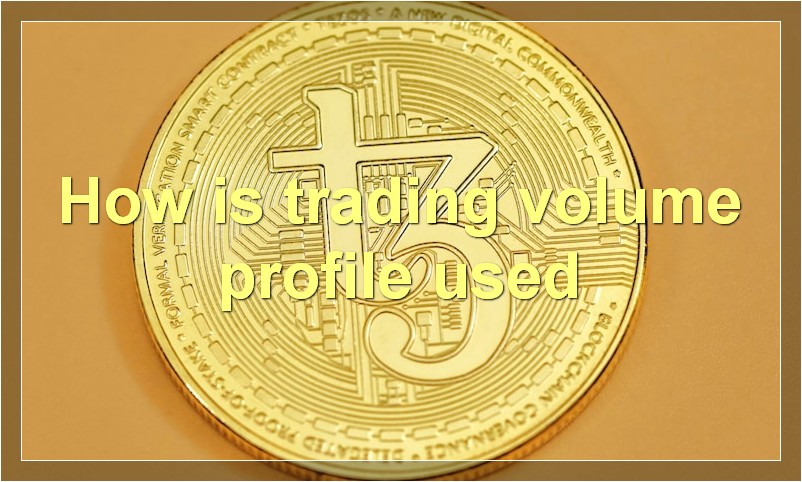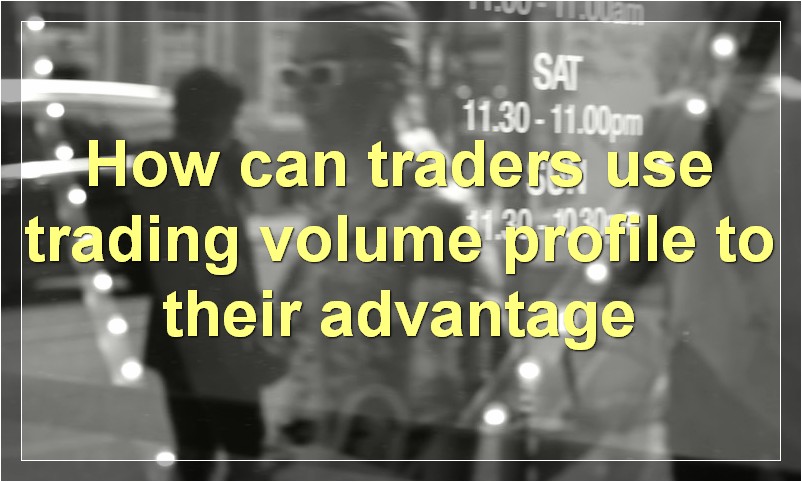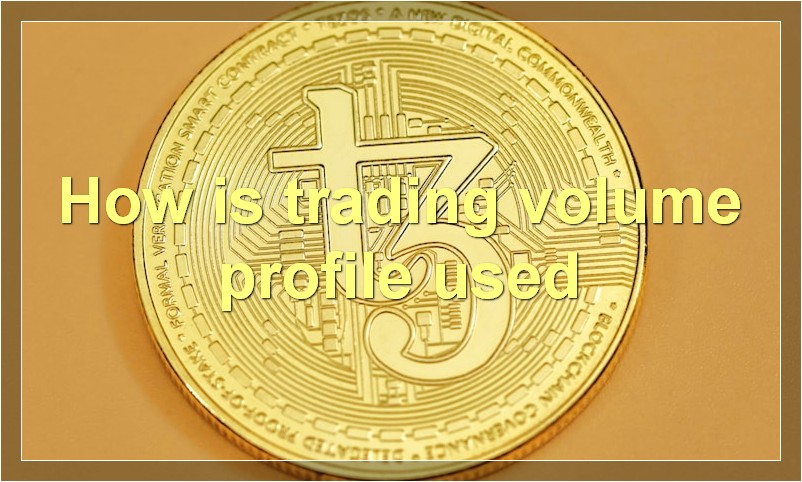If you want to take your trading to the next level, you need to start using volume profile. This powerful tool will help you find better entries and exits, and make better decisions in general. Here’s how to use volume profile to your advantage.
What is trading volume profile
In the world of trading, volume profile is an important tool that traders use to make decisions. It is a graphical representation of the trading activity in a security or market over a period of time. The profile shows the price at which the most trades occurred, as well as the number of trades that took place at that price.
Volume profile can be used to identify support and resistance levels, as well as to determine the best time to enter or exit a trade. When combined with other technical indicators, it can provide a more complete picture of the market and help traders make better informed decisions.
How is trading volume profile used

Trading volume profile is a tool that traders use to help visualize the amount of trading activity at different prices throughout the day. The volume profile is created by plotting the volume traded at each price level on a chart. This allows traders to see where the most trading activity is taking place and make decisions accordingly.
The volume profile can be used in a number of ways, but one common use is to help identify potential support and resistance levels. If there is a lot of trading activity taking place at a certain price level, it is likely that this price will act as a support or resistance level in the future. Traders can use this information to make decisions about where to enter and exit trades.
Another use for the volume profile is to help identify trends. If the volume profile shows a consistent pattern of increasing or decreasing activity at certain price levels, this can be an indication of a trend. Traders can use this information to make decisions about when to enter and exit trades.
The volume profile is just one tool that traders can use to make informed decisions. However, it is important to remember that no tool is perfect and that all information should be used in conjunction with other forms of analysis before making any trading decisions.
What are the benefits of using trading volume profile
The trading volume profile is a graphical representation of the trading activity in a security over time. It can be used to identify trends and support and resistance levels.
The profile is created by plotting the number of shares traded at each price level. The profile can be used to identify patterns and predict future market behavior.
Some benefits of using the trading volume profile include:
-Identifying trends: The profile can be used to identify whether a security is in an uptrend or downtrend. If the volume is increasing and the price is rising, this is an indication of an uptrend. If the volume is decreasing and the price is falling, this is an indication of a downtrend.
-Identifying support and resistance levels: The volume profile can be used to identify key support and resistance levels. These levels are where there is significant buying or selling activity and can be used to make trading decisions.
-Predicting future market behavior: The volume profile can be used to predict future market behavior. If there is significant buying activity at a certain price level, it is likely that the price will continue to rise. Similarly, if there is significant selling activity at a certain price level, it is likely that the price will continue to fall.
How can trading volume profile help traders
The volume profile is a graphical representation of the volume traded at different prices over a given period of time. The profile can be used to identify trading opportunities and market trends.
When the volume profile is rising, it indicates that there is more buying than selling pressure in the market. This can be used to identify potential buying opportunities.
Conversely, when the volume profile is falling, it indicates that there is more selling than buying pressure in the market. This can be used to identify potential selling opportunities.
What is the difference between trading volume and trading volume profile
The difference between trading volume and trading volume profile is that trading volume is a measure of the number of shares that are traded in a given period of time, while trading volume profile is a measure of the number of shares that are traded at each price level.
How can traders use trading volume profile to their advantage

When it comes to trading, volume is one of the most important indicators. It can be used to confirm trends, reversals, and breakouts. But what is volume profile? And how can traders use it to their advantage?
Volume profile is a tool that shows the amount of trading activity at different prices. This information can be used to identify potential support and resistance levels, as well as areas of value.
There are a few ways that traders can use volume profile to their advantage. First, it can be used to identify potential trading opportunities. If there is a sudden increase in volume at a certain price, it could signal that a breakout is about to occur. Similarly, if there is a sudden decrease in volume, it could signal that a reversal is about to occur.
Second, volume profile can be used to confirm trends and breakouts. If there is consistent volume at a certain price over time, it could signal that a trend is developing. And if there is a sudden spike in volume followed by a sustained increase, it could signal that a breakout is occurring.
Third, volume profile can be used to identify areas of value. If there is consistent trading activity at a certain price level, it could signal that this price is attractive to traders. Similarly, if there is very little trading activity at a certain price level, it could signal that this price is not as attractive to traders.
Overall, volume profile is a valuable tool for traders. It can be used to identify potential trading opportunities, confirm trends and breakouts, and identify areas of value. By understanding and utilizing volume profile, traders can gain a valuable edge in the market.
What are some things to keep in mind when using trading volume profile
When it comes to trading volume profile, there are a few things that traders need to keep in mind. First and foremost, volume profile can be a valuable tool in gauging market interest and potential activity. However, it is important to remember that volume can be easily manipulated, so it is important to take volume profile into context with other market indicators.
Another thing to keep in mind when using volume profile is that it can be a helpful tool in identifying potential support and resistance levels. By looking at where the majority of trading activity is taking place, traders can get a better idea of where key price levels may be.
Overall, volume profile can be a helpful tool for traders if used correctly. However, it is important to keep in mind that volume can be easily manipulated and that it should be taken into context with other market indicators.
How can trading volume profile be used to identify market trends
As the name suggests, trading volume profile is simply a profile of the volume traded at different prices over a given period of time. This data can be used to identify market trends, as well as potential support and resistance levels.
There are a few different ways to interpret volume profile data, but one of the most common is to look for “clusters” of volume. These clusters can indicate areas where there is significant buying or selling pressure, which can in turn be used to identify potential market trends.
Another way to use volume profile data is to look for “gaps” in the volume. These gaps can often be an indication of a change in market direction, and can be used as a leading indicator for trend changes.
Overall, volume profile can be a valuable tool for identifying market trends and potential trading opportunities. It is important to keep in mind that this data should be used in conjunction with other technical indicators, and should not be relied on exclusively.
What is the importance of volume in trading
Volume is one of the most important aspects of trading. It is a measure of how many shares or contracts are traded in a given period of time, and it can give traders important clues about the strength of a move or the health of a market.
High volume usually indicates that there is a lot of interest in a stock or market, and that prices are likely to move higher. Low volume, on the other hand, can be a sign that traders are losing interest and that prices may be due for a correction.
Volume is just one piece of information that traders should consider when making decisions, but it can be a helpful tool for finding opportunities and assessing risk.
How can traders use volume to their advantage
In trading, volume represents the number of shares or contracts traded in a given period of time, usually one day. It’s important to watch volume because it can be used as a leading indicator, helping traders predict price movements. Generally speaking, when volume is high, prices will move in the same direction; when volume is low, prices will move in the opposite direction.
There are a few ways that traders can use volume to their advantage. First, they can use it to confirm price movements. If prices are moving up and volume is increasing, that’s a good sign that the trend is strong and likely to continue. Conversely, if prices are falling and volume is decreasing, that’s a sign that the trend is weakening and may soon reverse.
Second, traders can use volume to identify potential turning points in the market. If prices are rising but volume is falling, that could be a sign that the uptrend is losing steam and may soon reverse. Similarly, if prices are falling but volume is rising, that could be a sign that the downtrend is nearing its end and may soon turn around.
Lastly, traders can use volume to gauge market momentum. When prices are rising and volume is increasing, that’s a sign of strong upward momentum. Conversely, when prices are falling and volume is decreasing, that’s a sign of downward momentum. By keeping an eye on market momentum, traders can better time their entries and exits.

